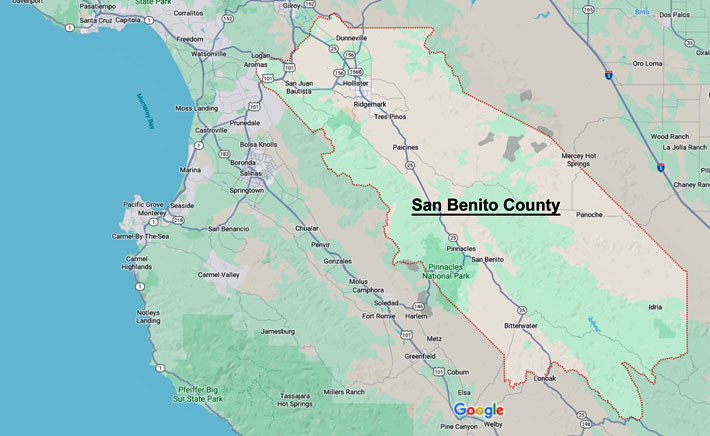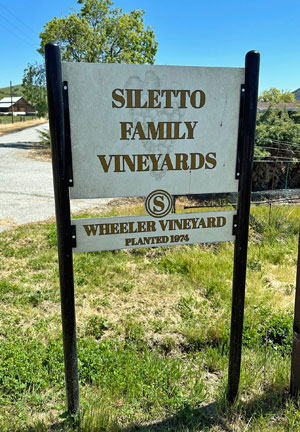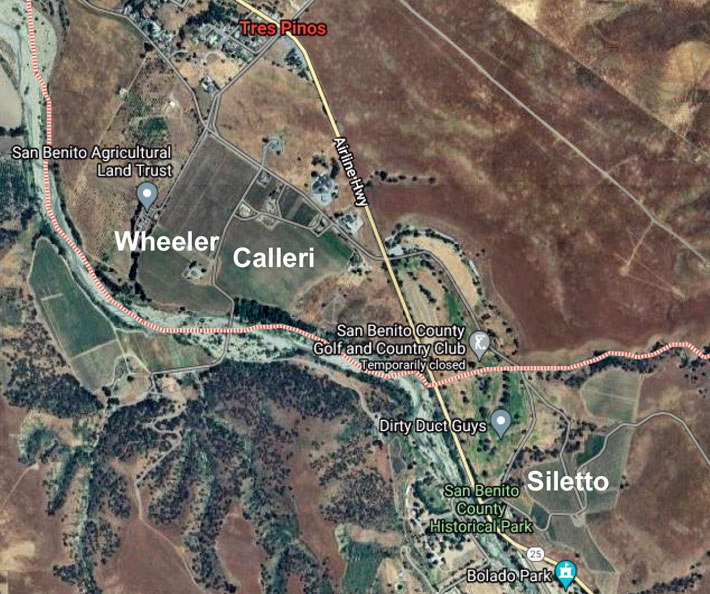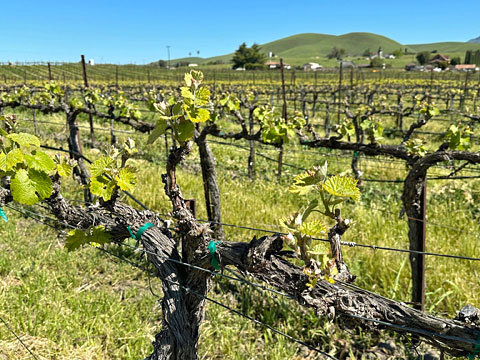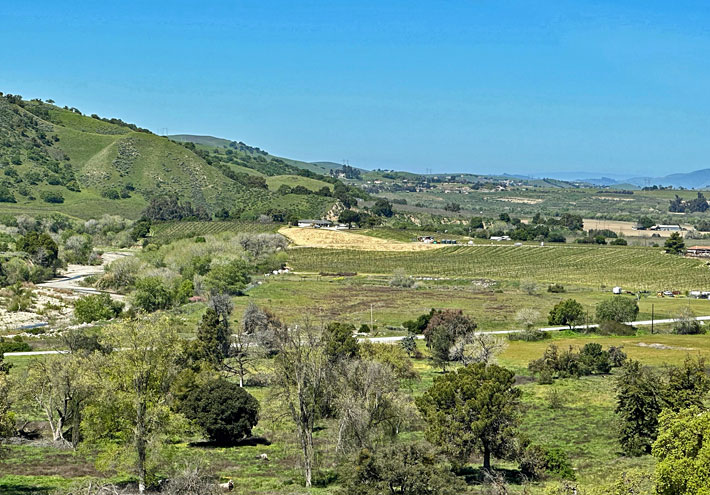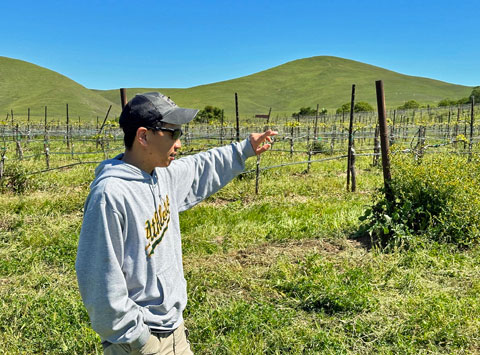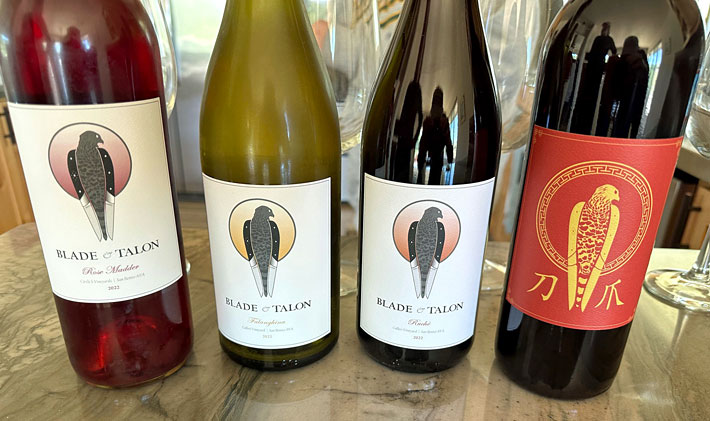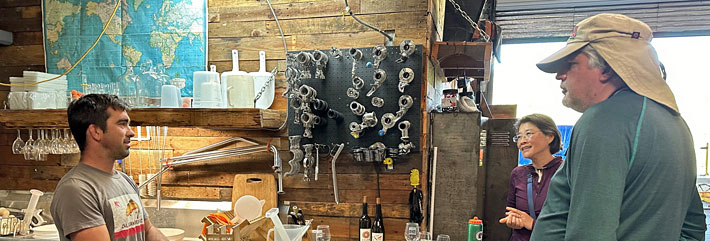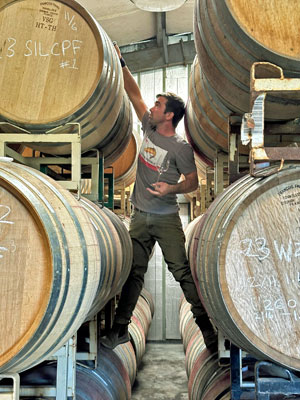San Benito Vineyards and Wine - April 2024
I’ve been wanting to visit some of San Benito County’s vineyards and try more wines from this under-the-radar California wine region, and the opportunity to get a start on that came up recently. I was able to make a couple of appointments for a Tuesday daytrip, and a couple of friends, Wes and Stephanie, joined me. Although a couple of other possible appointments that day fell through, this would be a good start to exploring San Benito County’s long history with wine and to checking out some of the exciting newer wines being made from the region’s fruit. I plan to return to the area in the future.
It was a beautiful morning as we drove south through San Jose and then turned onto Highway 25, the main road through San Benito County. Passing through the county’s largest town, Hollister, we soon came to the much smaller town of Tres Pinos, then turned off of the highway onto a small local road that led us to our first destination of the day.
Before proceeding further, it might be useful to provide a brief introduction to San Benito County and its place in California wine history.
Introduction to San Benito County
The vineyards of San Benito County include some of the older plantings in California, yet they’re not very well-known, even among many fans of California wine. The region is located south of Santa Clara Valley and east of Monterey County, between the Gabilan and Diablo mountain ranges. It’s generally quite warm during the summer, though afternoon maritime breezes coming down from Monterey Bay and through the Hollister area help to temper the heat. Historically, agriculture and mining (mainly for quicksilver) have been important to the county’s economy, though mining operations have fallen off over the years. The region includes two major earthquake faults – the San Andreas and Calaveras faults run through the county, contributing to its interesting geology and mix of rock and soil types, including volcanics, decomposed granite, and limestone, as well as some rare minerals.
The first commercial winegrape plantings in San Benito County came around 1851, when Frenchman Theophile Vaché planted vines in Cienega Valley, at what are now Eden Rift (formerly Pietra Santa) and DeRose vineyards. William Palmtag purchased Vaché’s vineyard in 1883 and expanded it, adding more grape varieties. It’s been said that some vines planted in the mid-1850s remain at DeRose. Enz Vineyard, in the same area, may have first been planted as early as the 1880s, and some of those vines are still producing. Other vineyards that were initially planted by the early 1900s include Wirz and Gimelli (formerly El Gabilan). Wirz also has Riesling vines dating to the 1960s. Josh Jensen began planting his Calera vineyards in the Mount Harlan area in 1974. San Benito County’s vineyard heyday came in the 1970s when wine giant Almaden had extensive vineyards in the area. But that era didn’t last long for the region, and many of those vineyards are gone now. Newer plantings of note in the past 30-40 years include Siletto Family Vineyards, Vista Verde, and Paicines Ranch.
San Benito County includes five AVAs entirely within the county borders: Cienega Valley (1982), Lime Kiln Valley 1982), Paicines (1982), San Benito (1987), and Mount Harlan (1990). There are also three AVAs that are partially within San Benito County, including their most recent one, Gabilan Mountains (2022).
In the past ten years or so, a number of smaller-scale vintners have discovered the vineyards of San Benito County and have sought out fruit from there, particularly older plantings of varieties such as Négrette and Cabernet Pfeffer, which may not be grown anywhere else in California. And the newer vineyards in particular have planted or grafted many varieties originally from Italy, Spain, Greece, France, and elsewhere in Europe that are little-known in California vineyards. Nearly all of these vintners make their wines outside of San Benito County, and there are still very few wineries within the county itself.
Siletto Family Vineyards
Our first San Benito County stop of the day was at Siletto Family Vineyards in Tres Pinos. I was introduced to the Siletto vineyards through Bryan Harrington of Harrington Wines in San Francisco, where I worked part-time for many years until Bryan decided to close down his winery after the 2018 vintage. Bryan initially was looking for Négrette grapes – there’s very little of this old California heritage variety (where it was once called Pinot St. George) that originated in southwestern France still planted in the state, where it’s almost exclusively found in San Benito County. Bryan learned that there was Négrette available from grower Ron Siletto and bought some in 2012, and he became one of the first to vineyard-designate Siletto on wine labels. In succeeding years, he increased his yearly purchases from Ron to 4-5 varieties and ultimately to over a dozen varieties in 2018. Bryan also encouraged Ron to graft many Italian grape varieties – a number of which are still rarely-seen in California – at his vineyard sites and Ron was enthusiastic about doing that, wanting his vineyards to better reflect his Italian heritage. During the years that the two worked together they also became friends, and even though Bryan was no longer making wine in 2020 he was heartbroken when Ron passed away in July of that year.
Ron’s parents came to the US from the Piemonte region of Italy, and he was born in Boston in 1933 – Italian was his first language as a child. After graduating from Boston College and serving five years in the Navy, he worked in the advertising business. From there he went to work for Almaden Vineyards, then one of the largest wine companies in California, and ultimately became the company president. Among Almaden’s properties were extensive vineyards and a couple of winery facilities in San Benito County, and Ron became familiar with the region. When Almaden was sold to Heublein in 1986, Ron purchased one of their small ranch properties in San Benito County and launched a further chapter in his career, farming vineyards. Over the following years, he expanded his vineyard operations from that initial 20-acre planting to six sites with over 170 acres and about 40 grape varieties. Ron loved working with the more esoteric varieties that have found a special home in San Benito County, such as Négrette and Cabernet Pfeffer, and he was able to plant some of these at his vineyards.
Since Ron’s passing, his son John has headed Siletto Family Vineyards. John sometimes worked with his father but his main career was at Driscoll’s – well-known for their strawberries as well as other berries – where for 25 years he gained knowledge in farming and eventually ran their nurseries. Siletto Family Vineyards has now consolidated to three vineyard sites with around 90 planted acres. They’ve also completed their transition to organic farming and are now certified by the California Certified Organic Farmers (CCOF) organization. John – along with Nat Wong, who now manages the vineyards – is working to improve soil health and position the vineyards so they will continue to produce high-quality fruit for years to come.
I was able to get in touch with Nat, who took the position of Siletto Family Vineyards general manager in early 2023, to arrange our visit there. Wes, Stephanie, and I met him outside of the house where he lives on the Wheeler Vineyard property, one of three current Siletto vineyard sites. The house is on a small hill, affording a good overview of the area and all three of the vineyards. Wheeler Vineyard, which the Siletto family owns, and Calleri Vineyard, which they lease, are adjacent to one another on the west side of Highway 25 and just east of Tres Pinos Creek. Siletto Vineyard is a little farther east, across the highway. Each of the three vineyard sites has about 27-30 acres planted, and the Siletto property also includes around 60 acres in addition to the vineyards.
After Nat gave us a quick overview of the area from in front of the house, we all got into his truck for a tour of the vineyards, starting with Wheeler. First planted with Cabernet Sauvignon vines in 1974, Wheeler Vineyard is now on the registry of the Historic Vineyard Society. Wente clone Chardonnay was planted 1977 and Brunello clone Sangiovese in 2007. The Cabernet and Chardonnay vines are all on old AXR1 rootstock at Wheeler – this was once recommended in California as a phylloxera-resistant rootstock but that has proven not to be the case. Nat said that the combination of sandy loam soil and the isolated vineyard location has kept the vines free of phylloxera.
Other than the 10-acre Cabernet Sauvignon block and 17.5-acre Chardonnay block at Wheeler, none of the blocks at any of the three Siletto Family Vineyard sites are more than four acres in size, and many of them are less than one acre. We stopped near the top of the gently-sloping site to take a closer look at the gnarly 50-year old Cabernet Sauvignon vines. Nat told us that they will be grafting Frappato onto some of the Chardonnay at Wheeler Vineyard, as well as Schiava and Mencía.
As we talked, I asked Nat why there is no San Benito wine association or grapegrowers association as is the case with so many other California wine regions. He said he and others have looked into this but there’s not much interest, largely because there are relatively few vineyards and even fewer wineries in San Benito County.
Getting back into the truck, we continued to the adjacent Calleri Vineyard. Nat said that much of this site was originally planted to Merlot in 1994, but the vines have been grafted to many other varieties in recent years, including Falanghina, Sagrantino, Greco di Tufo, Aligoté, Négrette, Mourvèdre, and Cabernet Franc. We stopped to look at some of the original Négrette vines at Calleri, which were also planted in 1994.
As mentioned earlier, Ron Siletto was excited about grafting lesser-known Italian varieties in his vineyards, and these newer varieties – as well as some of the older ones such as Cabernet Pfeffer and Négrette – have attracted a lot of new customers for the vineyards’ fruit. Nat and Ron’s son John are planning to continue on this path of grafting interesting varieties at the three sites. Fiano, Grillo, and Nero d’Avola are some of the varieties that Nat told us they will probably graft in the coming years. He said that they’re still experimenting with the right locations for many of these new grafted vines, and that they may shift some from one vineyard or block to a different one over the next few years.
|
| Negrette, at Calleri Vineyard |
As we looked at the rows of older Négrette vines at Calleri Vineyard, Nat told us that he’s working on a mix for cover crops. What’s there now is native vegetation, and Nat plans to retain some of that but supplement it with new cover crops that will attract pollinators as well as host beneficial predator insects. He showed us bee hives that a local organization has placed adjacent to the vineyard. He also said that predator bird boxes will be added at various locations at the three vineyard sites, to help control gophers and other vineyard pests. He noted that wild pigs have sometimes been a problem, as they are increasingly in a number of California vineyards, and that they are particularly prevalent in San Benito County. Nat told us that they plan to add some hedgerows that they hope will both deter the pigs as well as provide additional beneficial insect habitat.
Nat took us from Calleri Vineyard out to Highway 25, where we headed south for just a very short distance, and then to Siletto Vineyard. Unlike the gently-sloping Wheeler and Calleri sites, Siletto is on a hillside – some portions are quite steeply sloped while other parts are alluvial terraces. The soil here is rockier gravelly loam plus some calcite, a type of limestone found in San Benito County. As with Calleri, over a dozen grape varieties are currently grown at Siletto, a number of them grafted in the past five years. We stopped briefly to look at a planting of Grenache that Nat told us would be largely grafted to other varieties soon, including more Sagrantino and Montepulciano, as well as Freisa, which the family had grown at one of the sites they no longer farm. Varieties higher up on the hillside include Mencía – this is now the only Spanish variety at any of the three vineyard sites but Nat said that they may look to graft other ones in the future. The oldest ungrafted vines at the Siletto site are own-rooted Cabernet Pfeffer that date from 1992.
|
| View from Siletto to Calleri and Wheeler, Tres Pinos Creek at left |
We stopped on our way back down the hill at a spot where we could get a good look back toward the Wheeler and Calleri vineyards across the highway. We could also see the gap in the hills to the west where mid-afternoon maritime winds blow in to help moderate the warm summer temperatures in the area. Nat noted that the area where the Siletto vineyard sites are located includes two notable waterways (Tres Pinos Creek and San Benito River), two mountain ranges (Gabilan and Diablo), plus the San Andreas and Calaveras faults. This complexity of geological features helps give the region a wide range of rock and soil types as well as a diversity of native plants and animals.
We talked with Nat about the explosion of new customers for the Siletto Family Vineyards fruit over the past few years. For many years, Ron Siletto sold his fruit mainly to larger companies such as Mondavi, Gallo, and Constellation that used it in blends. But even early on he also sold to a small number of vintners who were interested in the more esoteric varieties that he grew, such as the Négrette and Cabernet Pfeffer. Ken Volk was the best-known of these vintners, first when he was the winemaker at Wild Horse Winery in the Paso Robles area and later when he launched his own label. Siletto Family Vineyards now sells fruit to about 50 customers, none of them very large and many of them quite small and not well-known. Most don’t buy a lot of fruit, but that sort of flexibility to sell to smaller-production vintners is a big part of what has drawn them to Siletto. Nat manages the vineyards and maintains a small year-round crew – the main vineyard hand Manuel Mora has been there for over 30 years. Nat said that he actually prefers to work with selling smaller lots of fruit so their own crew can handle picking the fruit themselves, helping to keep costs down.
|
| Nat points out Mencia vines, at Siletto Vineyard |
Nat told us how he keeps in touch with each customer as the growing season progresses, and takes fruit samples often so he can transmit information to the customers. To better do this, he now has a Foss machine that can quickly produce a detailed panel of data of the fruit samples. Before he came to Siletto, Nat had been a winery enologist, so this background is a great help in his ability to deal with this aspect of his work at the vineyards. When I looked over the list of winery customers on the Siletto website, I was stunned both at how many I know and how many I didn’t realize purchase fruit from Siletto. Word has clearly spread that the Siletto family is willing to sell quality fruit to small and barely-established vintners when many other vineyard owners and managers won’t even talk to anyone who may only want to buy a ton or two.
This was a fun visit with Nat to the Siletto Family Vineyards, and we had a terrific time with him as he gave us a tour of all three vineyard sites. Though they’re not as old as some of the vineyards in nearby Cienega Valley, the Siletto vineyards include a more diverse selection of different grape varieties than any other vineyard in the region, and many of these varieties are quite rare in California. It was great to hear that Nat and the Siletto family are planning to continue adding even more of these really interesting varieties in the future. And it was also encouraging to hear of their dedication to continue improving their organic farming methods to help keep the soil and the vines as healthy as possible for years to come. With so many smaller-production wineries now purchasing fruit from Siletto for their wines, I think we can expect to see even more vineyard-designated wines from there in the coming years – something to look for at your local and online wine shops.
Blade & Talon Wine
When I arranged a visit to Siletto Family Vineyards with Nat Wong, I wanted to make sure we would be able to spend a little extra time with him to talk about and taste wines from his own label, Blade & Talon. So after finishing our tour of the three Siletto vineyard sites we followed Nat into the house where he lives, on a small hilltop overlooking Wheeler and Calleri vineyards. We all gathered at the kitchen counter, and Nat told us more about his background.
Nat grew up in Danville in the East Bay. He earned a degree in evolution and ecology from UC Davis, after which he got a position working with seabirds and shorebirds at the Monterey Aquarium’s highly-regarded research facility. Nat has always had a love of birds, especially raptors, and he became a Master Falconer – he still finds time to take his hawk out in the mornings. That explains the “talon” part of his winery name, but what about “blade”? One of Nat’s other loves is knives. He collects them and is fascinated by how different knives have been developed in various parts of the world over many centuries to perform very specific tasks.
Nat had his wine epiphany while traveling in France in the spring of 2018. Visiting the Loire Valley, he had his first glass of Cabernet Franc at a restaurant overlooking the local vineyards. He’d had very little experience with wine at all up until then, but that wine struck a chord with him in such an intense emotional way that he knew he needed to change direction in his life.
After returning to California, Nat began to look for a harvest intern position at a winery, and was able to find one at Folktale Winery & Vineyards in Carmel Valley, not too far from where he lived at the time in Monterey. Nat became a full-time cellar worker at Folktale following the 2018 harvest and crush, eventually working his way up to becoming their enologist in 2021. He was able to work with a wide array of grape varieties from different growing regions at Folktale. Nat was eager to keep learning more, and visited with as many viticulturists and winemakers as he could, while also starting on the winemaking certificate program through UC Davis Continuing Education, which he completed in early 2022.
During 2019 the cellarmaster at Folktale encouraged Nat to make some wine on his own, and he searched for someone who would sell him a small quantity of fruit. Most vineyard managers are understandably reluctant to deal with such a small buyer, especially a first-time winemaker. But in the course of buying a wine tank from vintner Bryan Harrington in San Francisco, Bryan suggested that Nat get in touch with grower Ron Siletto in San Benito County, whom Bryan had been working with for a number of years. Nat followed up on Bryan’s suggestion, and Ron not only offered him some fruit from his vineyard but struck up a friendship with him, as he’d also done with Bryan.
While that initial meeting with Ron may not have been as dramatically life-changing for Nat as his glass of Cabernet Franc in the Loire Valley, it turned out to be of major importance to him as he’s become a key member of the Siletto family vineyard operation since Ron passed away in 2020. Nat made his first Blade & Talon wine from Siletto Family Vineyards fruit, a Rosé of Barbera in 2020, and he moved on from Folktale to become the general manager and vineyard manager of Siletto Family Vineyards in early 2023. Nat loves living at the house at Wheeler Vineyard, and he told us that the Tres Pinos area reminds him of how the Danville area used to be when he was growing up, with open fields and lots of birds.
Nat has grown the Blade & Talon label from his initial tiny release to a typical production of about 700-750 cases per year. Last year he moved his wine production from the Folktale winery to Atelier des Savants Fous – it’s a fairly new facility in Gilroy that’s becoming an incubator for winemakers growing their businesses.
Nat sources all his fruit from San Benito County, mostly from Siletto Family Vineyards. He said that he’s trying to make distinctive wines that reflect their place and vintage rather than trying to emulate Burgundy, Bordeaux, or some other European wine region. He practices low-intervention winemaking methods, with native fermentation, no additions, mainly neutral oak aging, and no fining or filtering. He uses a lighter touch on his winemaking, and although he’s inspired by the style of wines of the Loire Valley he’s not trying to reproduce Loire wines in California. Most of the Blade & Talon wines are aimed for quick turnaround, with whites, rosés, and chillable reds, not necessarily meant for extended aging. Nat wants to keep his production to about six different wines each year, and since he has some graphic art experience he does his own label design.
It was time to taste some of the Blade & Talon wines, and since it was about lunchtime Stephanie brought in a loaf of her homemade rosemary and garlic bread along with cheese from Marin French Cheese Company. Nat opened four of his current release wines for us to taste, starting with the 2022 Falanghina. This had six days of skin contact prior to pressing, and was then aged on the lees in neutral French oak. Nat likes to have some skin contact on his white wines for the texture it provides, and he feels that Falanghina works particularly well with this technique. The wine featured fresh stone fruit aromas with citrus undertones and a mildly leesy note, with great texture and a lively finish. Nat told us that his 2023 Falanghina will be blended with some Greco di Tufo – Nat used a little pine resin during fermentation of this wine, but he doesn’t expect it to turn out like a Greek retsina.Next was a rosé wine, the 2022 “Rose Madder.” Nat made this using an interesting method – he submerged whole cluster Aglianico and Cabernet Pfeffer under the juice of direct-press Cabernet Sauvignon for 6-7 days before pressing the first two varieties, allowing for a partial carbonic fermentation. He noted that this means that the wine combines three fermentation methods – co-fermentation / carbonic fermentation / vin gris. With bright upfront black cherry and raspberry, this also had touches of flowers and earth, along with a bit more structure than many rosés. The 2023 vintage of this wine will be made from Montepulciano, Cabernet Pfeffer, and Sangiovese.
Moving on to red wines, Nat opened his 2022 Ruchè. He told us that Ruchè – originally from the Piemonte region of Italy and brought to California by Randall Grahm – is one of his favorite grape varieties. Displaying the variety’s intense floral and red fruited character, plus a touch of spice in the background, this had medium body with a bright finish. We finished up with the 2022 “Lucky Tiger” – a blend of 57% Cabernet Pfeffer and 43% Mourvèdre. This wine has a distinctive label, and was made during the Chinese Year of the Tiger. Nat, whose family has been in California since the 1850s, wanted to honor the many Chinese laborers who did much of the difficult work here over the years, including planting vineyards. The wine showed both red and black fruit aromas along with savory herbal and earthy notes in support, with a bigger and more structured mouthfeel and finish than the Ruchè. Nat told us that the 2023 vintage of this wine will be a “Lucky Rabbit” blend of Frappato and Montepulciano.
Other releases from the 2022 vintage include Négrette (a mix of destemmed and whole-cluster fermentations), “Vin Rouge” (44% Négrette, 34% Malbec, and 22% Cabernet Franc), and “Crackling” Orange Muscat Pét-nat – Nat described that one as a “breakfast wine,” sort of a pre-made mimosa! He mentioned that one of his upcoming wines will be a Loire-inspired red blend.
As we were finishing up, I asked Nat whether he would like to plant his own vineyard someday. He said he’d like to find a place for a small vineyard just for his own wines, and plant a few varieties including Pineau d’Aunis, Négrette, and Falanghina there. So we may have that to look forward to for future Blade & Talon wines!
Wes, Stephanie, and I had a really enjoyable tasting with Nat. Having spent a few hours with him during both our tasting as well as our earlier tour of the Siletto Family Vineyards, I thought that it was remarkable that he’s made such a quick and successful career pivot, already making terrific wines as well as doing a fine job of managing the Siletto vineyards. The Blade & Talon wines we tasted impressed me with their combination of lower alcohol levels with plenty of aromatics and flavor – not something that’s easy to do. I liked all of the wines we tried with Nat though my favorites were the 2022 Falanghina and 2022 Ruchè. Blade & Talon should be a label to keep an eye on in the coming years.
Stirm Wine Co.
Our final wine visit of the day was with Ryan Stirm of Stirm Wine Co. at his winery in the small town of Aromas, near Watsonville. His winery building is set back from the road and a little tough to find, but when we looked down the driveway spotted the stacks of empty plastic wine tanks outside we knew we were at the right place. We parked next to the building and in a moment Ryan came out and welcomed us. His winery is much like many other small, low-tech wine facilities I’ve seen – a simple steel building with not much more inside than some stainless steel tanks, stacks of barrels, kegs, and basic winery equipment. Ryan moved into this facility in 2017, which had previously housed River Run Vintners.
Ryan grew up in Contra Costa County, and was on his high school’s wrestling team. He and some of his teammates went on to Cal Poly-San Luis Obispo, as it had a good wrestling team, and soon Ryan found himself drawn to the university’s noted Wine and Viticulture program, while also studying soil science and sustainable agriculture. During his time at Cal Poly, he had an internship at Saucelito Canyon Winery in Arroyo Grande Valley, which was his first real experience with winemaking.
After Ryan earned his degree in 2011, he worked for four years with Justin Willett of Tyler Winery in Santa Barbara County, where he became the assistant winemaker. While he was there, he had the opportunity to work in the Margaret River region of Australia as well as in Austria. It was also while Ryan was still at Tyler that he made his first Stirm wine in 2013, a Riesling from Santa Barbara County. After moving back north and working for a time at Thomas Fogarty Winery in the Santa Cruz Mountains, he went out on his own in 2016. Ryan also began farming vineyards for some clients but the logistics proved to be difficult to handle, so he cut back on that and now farms only his own small vineyard, located right next to his winery – more on that later.
Although Ryan works with a number of grape varieties, his Stirm label has become particularly known for two of them. Right from his first vintage, he’s worked with Riesling, a favorite of his, and he’s now recognized as one of California’s top Riesling producers. Ryan said that he likes how Riesling reflects different sites and how versatile it can be, though he mentioned that it’s not the easiest variety to sell. Stirm is also known for Cabernet Pfeffer, the rare variety – originally called Mourtaou, from the Bordeaux region – that may now only be grown in San Benito County. Ryan told us that he makes about 600 cases per year of Cabernet Pfeffer, probably more than anyone else in the world. With a few exceptions – notably his Kick-On Vineyard Riesling from Santa Barbara County – he works with fruit mostly from San Benito County and the Santa Cruz Mountains, both not far from his winery. In addition to his Stirm label, Ryan partners on two other labels. He makes Los Chuchaquis wines with Jehan Hakimian, and is one of the vintners for Companion Wine Co., where he makes Riesling and Rosé that’s packaged in cans.
Wes, Stephanie, and I talked a little with Ryan about his low-intervention winemaking methods. All of his wines undergo native fermentations – he told us that they haven’t needed inoculation but that he takes care to make sure the fermentations start and proceed smoothly. He stressed that his winemaking does not follow any set recipes and is not dogmatic. Destemmed vs. whole-cluster fermentations for red wines varies according to the variety and vintage – Ryan noted that he destemmed more of his 2023 fruit as it needed extra sorting due to more botrytis mold in that vintage. He also told us that SO2 additions are dependent on specific wines. He overvintages about 1/3 of his wines – that is, he doesn’t bottle it until after the following vintage. Doing this takes up more room in the winery and delays getting those wines into the market, but Ryan feels the additional aging makes these wines better.
Before we began tasting with Ryan, he asked if we wanted him to focus on his wines sourced from San Benito County vineyards, and we told him that would be ideal since wine from this region was our main interest on this day. He works with some of the older vineyards in this region. Gimelli Vineyard in Cienega Valley was formerly known at El Gabilan, and the Cabernet Pfeffer vines that Ryan gets fruit from there go back over 120 years. Nearby Wirz Vineyard has 1902 plantings that include Zinfandel, Rosa del Perú (Mission), and Cabernet Pfeffer, as well as Riesling that dates to 1963. Siletto Family Vineyards is not as old as Gimelli or Wirz but includes some older Négrette and Cabernet Pfeffer vines.
Ryan got out some wineglasses and proceeded to sample us on some of his wines. As usual with tank and barrel samples, my notes on these are brief since they’re not yet finished wines. Ryan led off with three tank samples, beginning with 2023 Gimelli Vineyard Chardonnay. Made by direct press, this wine will spend 11 months in neutral oak before bottling – the wine displayed lemon, flowers, and a touch of earth on the nose with a bright finish. Next was the 2023 Wirz Vineyard Riesling – showing stone fruit aromas plus floral notes and vibrant acidity, this won’t be bottled for another 16 months. Our final tank sample was the 2022 Wirz Vineyard Riesling – this will go into bottle this summer. This was a great example of what an additional year of aging adds to the Wirz Riesling, as this one showed much more complexity – including added petrol and herbal aromas and more weight on the palate – than the very young 2023 sample.
We moved on to barrel samples – all from neutral oak – and started with a couple of white wines. First was the 2023 Skin-contact Wirz Vineyard Riesling, which was on the skins for 17 days – one of the few skin-contact wines that Ryan works with. This featured bright floral, melon, and lychee aromas with a pleasantly chalky mineral texture. He then gave us a taste of the 2023 Pajaromas Vineyard Vermentino / Albariño from his own small vineyard next to the winery – stone fruit and citrus notes with bright acidity.
Proceeding to red wines, Ryan had us taste the 2022 Wirz Vineyard Zinfandel from an older puncheon – the wine displayed ripe red berry fruit plus plenty of spice and moderate tannins. He told us that he finds Zinfandel the toughest variety to work with due to its tendency for uneven ripening and susceptibility to botrytis mold. Next up was the 2023 Wirz Vineyard Rosa del Perú (Mission). Ryan said that although it’s not one of his favorite varieties it can still make distinctive wine, and its long history in California is compelling. This one had earthy and spicy red fruit with a medium-light texture and more tannin that you might expect.
We finished our barrel tasting with wines made from a couple of San Benito County’s most historic varieties. The 2023 Siletto Vineyard Cabernet Pfeffer was made mostly from destemmed fruit. Bright and earthy, it showed a darker fruit profile, lots of spice, and good structure. We followed that with the 2023 Gimelli Vineyard Cabernet Pfeffer – this featured raspberry and earth aromas plus herbal undertones, with more tannic grip than the previous wine. Our last barrel sample was the 2023 Siletto Vineyard Négrette, with brushy and earthy red and black fruit and moderate tannins. Ryan said that this Négrette will be blended with Zinfandel and Cabernet Pfeffer. The wine from all of the other barrels we sampled will go into single-varietal bottlings.
We walked over from the barrels to taste three bottled wines that Ryan opened for us. First was the 2022 “Benitoite” – a blend of 45% Cabernet Pfeffer, 31% Zinfandel, and 23% Négrette, all from San Benito County. The blend includes the three historically important red grape varieties from the region, and the name of the wine comes from a rare mineral found in San Benito County that’s the state gem of California. The wine displayed bright raspberry fruit with earthy, lightly floral, and peppery notes in support, medium-full body, and a firm tannic finish – could use a bit more time in the cellar to develop further but it’s nice right now too. We also tried the 2020 Wirz Vineyard Cabernet Pfeffer, which Ryan told us was made with about 50% whole-cluster fermentation. This had a darker fruit profile than the “Benitoite” with a bigger pepper component along with earth and spice, and plenty of structure on the palate and finish. He opened one more wine for us, the Los Chuchaquis 2023 “Champelli” Sparkling Albariño, sourced from C5 Vineyard in Santa Ynez Valley – stone fruit, flowers, and orangepeel on the nose with a lightly bubbly texture and bright, pleasant finish.
Ryan asked us if we’d like to take a look at his vineyard, and of course we couldn’t pass that up! The two-acre vineyard is named Pajaromas, for the Pajaro River just to the east and the small town of Aromas. About 75% of the vineyard is planted to Vermentino and the rest is Albariño and Furmint. The vines were planted in 2021, and they’re trained on vertical cordons. Ryan chose this system to help control the vigor of the vine growth. It will take a few more years for the vines to become established there, but Ryan is hoping he’ll be able to dry-farm them in the future. He was able to harvest a small amount of fruit in 2023, though he told us that birds got most of it. He expects this year he’ll have a better crop to harvest. Ryan said that he’d like to find a good location in the nearby area where he can plant a larger vineyard at some point.
In addition to Riesling, Chardonnay, Zinfandel, and Cabernet Pfeffer, Ryan also works with Pinot Noir for the Stirm label. One of his Pinots is called “Joaquinite” for another rare San Benito gemstone. There’s another gemstone wine, “Neptunite” Rosé – it’s a blend of mostly white varieties with a splash of red – and also the “Calcite” blend of Chardonnay and Riesling, named for the unusual type of limestone soil that’s found in a number of San Benito vineyards. Ryan expects to bottle around 3,600 cases under the Stirm label from the 2023 vintage, while the Los Chuchaquis production will be about 1650 cases and Companion about 800. Ryan had some exciting news for those who would like to taste his wines – he’s working on a downtown Santa Cruz tasting room, which hopefully will be open within the next year.
Wes, Stephanie, and I had a great time visiting with Ryan at his winery and it was a bonus to check out his vineyard as well. It should be interesting to see how the vines there develop over the next few years and to find out how Ryan’s wines from his vineyard turn out. Ryan makes a very diverse and distinctive group of wines – I’ve enjoyed his Stirm wines for a number of years as well as the few Los Chuchaquis bottlings I’ve tried (I haven’t yet tasted the Companion wines). It was his Rieslings that first caught my attention, and they have remained a strength, while his work with San Benito heritage varieties and other varieties creates a lineup of wines that are unlike any other label I know of in California. I’ve found the Stirm wines to be very well-made and to show transparency with regard to their variety, vintage, and region. My favorites of the tank and barrel samples we tasted included the 2022 Wirz Vineyard Riesling, 2023 Skin-contact Wirz Vineyard Riesling, 2023 Pajaromas Vineyard Vermentino / Albariño, and 2023 Siletto Vineyard Cabernet Pfeffer. I really liked all three bottled wines, and if I had to pick one as my favorite I’d go with the 2022 “Benitoite.” I highly recommend trying Ryan’s wines.
I always enjoy visiting lesser-known California wine regions, and San Benito County certainly counts as one of those. Though it attained some success in the late 1800s and early 1900s, Prohibition wiped that out as it did in so many areas. And although vineyard plantings expanded greatly around the 1970s, most of these grapes went into large anonymous blends, not into anything labeled as San Benito. Things have been changing slowly since then, and there are clear signs that wines from the region are now gaining greater recognition and acclaim.
Siletto Family Vineyards is just one of the San Benito County vineyards – both old and new – that have become fruit sources for many up-and-coming winemakers as well as for some more established labels. With vintners such as Nat Wong of Blade & Talon, Ryan Stirm of Stirm, Los Chuchaquis, and Companion, and others using San Benito fruit in many of their wines, it’s becoming easy to associate the region with some of California’s most exciting new wines.
I only experienced a small portion of San Benito County and its wines on this short visit, and I’ll certainly return to visit other vineyards – particularly the older sites in Cienega Valley – as well as other vintners working with San Benito fruit. As always, thanks to everyone that I visited for being so generous with their time and their wine!
|


